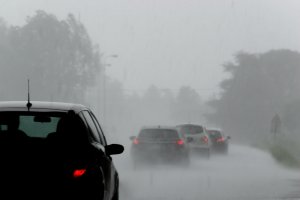When you think of hazardous driving conditions, what comes to mind? Winter roads? Winding mountain highways? What about heavy rain? According to the Federal Highway Administration, nearly 418,000 people are injured, and 5,000 people are killed each year in weather-related crashes, and upwards of 70% of these crashes take place on wet roads.
Any time you drive in the rain, be it a drizzle or torrential rain and flash floods, safety should be your top priority. With that in mind, here are a few of our most effective safety tips for driving in wet weather:
5 Ways to Avoid Hydroplaning on Wet Roads
No matter where you live, it’s impossible to avoid driving in the rain. Fortunately, you can take some proactive steps to stay safe while you do it. Here are our top tips:
1. Wait Until the Storm Passes
If your travel schedule allows, wait to hit the road until the weather improves. This is the best way to avoid the dangerous conditions associated with wet roads and to protect yourself and your fellow drivers. With heavy rain, even ten or twenty minutes can make a significant difference.
2. Maintain Your Vehicle
Driving in heavy rain is dangerous enough – there’s no reason to make it harder by heading out on bald tires or without working taillights. No matter what the weather is doing, you should maintain your vehicle well.
This means checking and adjusting your tire pressure, replacing windshield wipers, as needed, and having your oil changed regularly. These things sound simple, but they can make a substantial difference when it comes to staying safe on the road in bad weather.
3. Decrease Your Speed
Did you know that driving too fast is one of the significant risk factors for hydroplaning? If a storm hits while you’re out on the road, drive much slower than you would otherwise. Your vehicle’s reaction time increases on wet roads, and you can reduce your risk of an accident by merely allowing yourself extra stopping time.
4. Turn on Your Headlights
Turning on your headlights increases visibility, both by allowing you to see further and by allowing other vehicles to see you more easily. If you often forget to turn on your lights, set them to the automatic setting, where they’ll turn on any time weather reduces visibility.
5. Avoid Standing Water
During heavy rains, puddles can be misleading. Something that seems to be only an inch or so deep may be several inches deep, and can easily cause hydroplaning. With this in mind, avoid areas of standing water as much as possible. If you can’t avoid standing water, slow down before driving through.
Staying Safe in Pensacola’s Wet Season
You can’t avoid the rain, but you can learn how to navigate it intelligently. By following the tips above, you can keep yourself, your passengers, and your fellow drivers safe. Last by not least, be sure to turn around and avoid the weather if it is severe or hazardous. You know what they say about driving in flood conditions here in Florida: “Turn around, don’t drown.”
Need help getting your car ready for wet weather? Contact the team here at DeBroux Automotive today.
